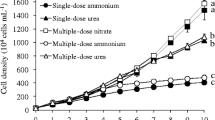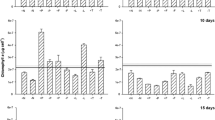Abstract
The use of glyphosate, which is a well-known sterilant herbicide, has been growing rapidly because the area under the cultivation of genetically modified crops that are tolerant to this herbicide has increased. Glyphosate can enter into aquatic systems through many different ways. However, information on the potential risks of glyphosate at environmentally relevant levels to aquatic systems is still limited. In this study, we selected the cyanobacterium Microcystis aeruginosa FACHB-905 (M. aeruginosa) as a model organism to evaluate the effects of glyphosate at environmentally relevant concentrations on the former’s growth and microcystin (MC) production. Our results show that low levels of glyphosate stimulate the growth of M. aeruginosa. Subsequently, there was significant increase in the total MC-LR and intracellular MC-LR, but not in extracellular MC-LR, after exposure to 0.1–2 mg/L of glyphosate. The increase in total MC-LR is mainly due to the effects of glyphosate on the cell density of M. aeruginosa. The data provided here show that low level of glyphosate in a water body is a potential environmental risk factor that stimulates the growth and enhances MC production in M. aeruginosa, which should arouse great concern.







Similar content being viewed by others
References
Botta, F., Lavison, G., Couturier, G., Alliot, F., Moreau-Guigon, E., Fauchon, N., Guery, B., Chevreuil, M., & Blanchoud, H. (2009). Transfer of glyphosate and its degradate AMPA to surface waters through urban sewerage systems. Chemosphere, 77(1), 133–139.
Calabrese, E. J., & Baldwin, L. A. (2003). Hormesis: the dose-response revolution. Annual Review of Pharmacology & Toxicology, 43(1), 175–197.
Coupe, R. H., Kalkhoff, S. J., Capel, P. D., & Gregoire, C. (2012). Fate and transport of glyphosate and aminomethylphosphonic acid in surface waters of agricultural basins. Pest Management Science, 68(1), 16–30.
Currie, Z., Prosser, R. S., Rodriguez-Gil, J. L., Mahon, K., Poirier, D., & Solomon, K. R. (2015). Toxicity of Cúspide 480SL® spray mixture formulation of glyphosate to aquatic organisms. Environmental Toxicology & Chemistry, 34(5), 1178–1184.
Davis, T. W., Berry, D. L., Boyer, G. L., & Gobler, C. J. (2009). The effects of temperature and nutrients on the growth and dynamics of toxic and non-toxic strains of microcystis during cyanobacteria blooms. Harmful Algae, 8(5), 715–725.
Demir, U. E. N. (2009). Toxicity of glyphosate and ethoxysulfuron to the green microalgae (Scenedesmus obliquus). Journal of Chemistry, 21(3), 2163–2169.
Duke, S. O., & Powles, S. B. (2008). Glyphosate: a once-in-a-century herbicide. Pest Management Science, 64(4), 319–325.
Jähnichen, S., Long, B. M., & Petzoldt, T. (2011). Microcystin production by Microcystis aeruginosa: direct regulation by multiple environmental factors. Harmful Algae, 12(4), 95–104.
Jiang, J., Gu, X., Song, R., Zhang, Q., Geng, J., Wang, X., & Yang, L. (2011). Time-dependent oxidative stress and histopathological changes in Cyprinus carpio L. exposed to microcystin-LR. Ecotoxicology, 20(5), 1000–1009.
Kier, L. D., & Kirkland, D. J. (2013). Review of genotoxicity studies of glyphosate and glyphosate-based formulations. Critical Reviews in Toxicology, 43(4), 283–315.
Kist, L. W., Rosemberg, D. B., Pereira, T. C. B., Azevedo, M. B. D., Richetti, S. K., Leão, J. D. C., Yunes, J. S., Bonan, C. D., & Bogo, M. R. (2012). Microcystin-LR acute exposure increases AChE activity via transcriptional ache activation in zebrafish ( Danio rerio ) brain. Comparative Biochemistry & Physiology Part C Toxicology & Pharmacology, 155(2), 247–252.
Kong, F. X., & Gao, G. (2005). Hypothesis on cyanobacteria bloom-forming mechanism in large shallow eutrophic lakes. Acta Ecological Sinica, 25(3), 589–595.
Kwiatkowska, M., Paweł, J., & Bukowska, B. (2013). Glyphosate and its formulations—toxicity, occupational and environmental exposure. Medycyna Pracy, 64(5), 717–729.
Ma, M., Liu, R., Liu, H., & Qu, J. (2012). Chlorination of Microcystis aeruginosa suspension: cell lysis, toxin release and degradation. Journal of Hazardous Materials, 217–218(3), 279–285.
Neilan, B. A., Pearson, L. A., Muenchhoff, J., Moffitt, M. C., & Dittmann, E. (2013). Environmental conditions that influence toxin biosynthesis in cyanobacteria. Environmental Microbiology, 15(5), 1239–1253.
Nishiwaki-Matsushima, R., Ohta, T., Nishiwaki, S., Suganuma, M., Kohyama, K., Ishikawa, T., Carmichael, W. W., & Fujiki, H. (1991). Liver tumor promotion by the cyanobacterial cyclic peptide toxin microcystin-LR. Journal of Cancer Research & Clinical Oncology, 118(6), 420–424.
Ou, H., Gao, N., Wei, C., Yang, D., & Qiao, J. (2012). Immediate and long-term impacts of potassium permanganate on photosynthetic activity, survival and microcystin-LR release risk of Microcystis aeruginosa. Journal of Hazardous Materials, 219–220, 267–275.
Paerl, H. W., & Otten, T. G. (2013). Harmful cyanobacterial blooms: causes, consequences, and controls. Microbial Ecology, 65(4), 995–1010.
Papadopoulos, N. G. (1995). Iron-stimulated toxin production in Microcystis aeruginosa. Applied & Environmental Microbiology, 61(2), 797–800.
Qiu, H., Geng, J., Ren, H., Xia, X., Wang, X., & Yu, Y. (2013). Physiological and biochemical responses of Microcystis aeruginosa to glyphosate and its roundup ®; formulation. Journal of Hazardous Materials, 248–249(6), 172–176.
Sáenz, M. E., & Marzio, W. D. D. (2009). Ecotoxicity of herbicide glyphosate to four chlorophyceaen freshwater algae. Limnetica, 28(1), 149–158.
Sun, Q. F. (2013). Exploration on technology of efficient and environment-friendly herbicide glyphosate. Modern Agricultural Science & Technology, 19(1), 137.
Svircev, Z., Baltić, V., Gantar, M., Juković, M., Stojanović, D., & Baltić, M. (2010). Molecular aspects of microcystin-induced hepatotoxicity and hepatocarcinogenesis. Journal of Environmental Science & Health Part C Environmental Carcinogenesis & Ecotoxicology Reviews, 28(1), 39–59.
Tian, S., Liu, Z., Weng, J., & Zhang, Y. (1997). Growth of Chlorella vulgaris in cultures with low concentration dimethoate as source of phosphorus. Chemosphere, 35(11), 2713–2718.
Tonk, L., Visser, P. M., Christiansen, G., Elke, D., Snelder, E. O. F. M., Wiedner, C., Mur, L. R., & Huisman, J. (2005). The microcystin composition of the cyanobacterium Planktothrix agardhii changes toward a more toxic variant with increasing light intensity. Applied & Environmental Microbiology, 71(9), 5177–5181.
USEPA (2009). Basic Information about Glyphosate in Drinking Water. Drinking Water Contaminants–Standards and Regulations. Available At: https://www.epa.gov/dwstandardsregulations
Wang, J., & Xie, P. (2007). Antioxidant enzyme activities of Microcystis aeruginosa in response to nonylphenols and degradation of nonylphenols by M. aeruginosa. Environmental Geochemistry & Health, 29(5), 375–383.
Wang, C., Zhang, Q., & Zhang, X. F. (2010). Understanding the endocrine disruption of chiral pesticides: the enantioselectivity in estrogenic activity of synthetic pyrethroids. Science China (Chemistry), 53(5), 1003–1009.
Wang, X., Sun, M., Xie, M., Liu, M., Luo, L., Li, P., & Kong, F. (2013). Differences in microcystin production and genotype composition among Microcystis colonies of different sizes in Lake Taihu. Water Research, 47(15), 5659–5669.
Zhang, Q., Lu, M. Y., Wang, C., Du, J., Zhou, P. X., & Zhao, M. R. (2014a). Characterization of estrogen receptor α activities in polychlorinated biphenyls by in vitro dual-luciferase reporter gene assay. Environmental Pollution, 189, 169–175.
Zhang, Q., Ye, J. J., Chen, J., Xu, H. J., Wang, C., & Zhao, M. R. (2014b). Risk assessment of polychlorinated biphenyls and heavy metals in soils of an abandoned e-waste site in China. Environmental Pollution, 185, 258–265.
Zhang, Q., Qin, S., Li, J. l., Zou, M. l., Zhang, C. X., & Zhang, Q. (2016). Alteration of the enantioselective toxicity of diclofop acid by Nonylphenol: effect on ascorbate-glutathione cycle in Microcystis aeruginosa. Chirality, 28(6), 475–481.
Acknowledgments
This study was funded by the National Natural Science Foundation of China (21307109, 21337005, and 21377119).
Author information
Authors and Affiliations
Corresponding author
Rights and permissions
About this article
Cite this article
Zhang, Q., Zhou, H., Li, Z. et al. Effects of glyphosate at environmentally relevant concentrations on the growth of and microcystin production by Microcystis aeruginosa . Environ Monit Assess 188, 632 (2016). https://doi.org/10.1007/s10661-016-5627-2
Received:
Accepted:
Published:
DOI: https://doi.org/10.1007/s10661-016-5627-2




